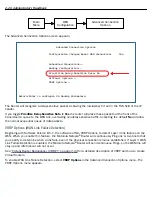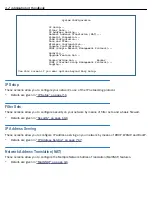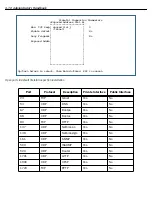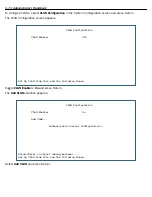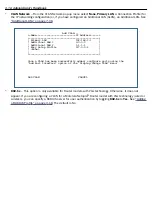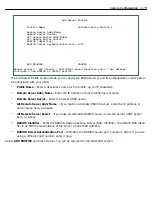
3-12 Administrator’s Handbook
Ethernet Switching/Policy Setup
Before you configure any VLANs, an unconfigured Gateway is set up as a router composed of a LAN switch, a
WAN switch, and a router in the middle, with LAN and WAN IP inter faces connected to their respective switches.
These bindings between Ethernet switch por ts, IP LAN inter face, IP WAN inter face and WAN physical por ts are
automatically created.
When you configure any VLANs, the default bindings are no longer valid, and the system requires explicit binding
between IP inter faces and layer 2 inter faces. Each VLAN can be thought of as a layer 2 switch, and enabling
each por t or inter face in a VLAN is analogous to plugging it in to the layer 2 switch.
Thereafter, in order for devices to communicate on layer 2, they must be associated in the same VLAN. For
devices to communicate at layer 3, the devices must be either on the same VLAN, or on VLANs that have an
Inter-VLAN routing group enabled in common.
When configuring VLANs you must define how traffic needs to be for warded:
•
If traffic needs to be bridged between LAN and WAN you can create a single VLAN that encompasses the
WAN por t and LAN por ts.
•
If traffic needs to be routed then you must define four elements:
• LAN-side VLANs
• WAN-side VLANs
• Associate IP Inter faces to VLANs
• Inter-VLAN Routing Groups: configuration of routing between VLANs is done by association of a VLAN to a
Routing Group. Traffic will be routed between VLANs within a routing group. The LAN IP Ethernet Inter face
can be bound to multiple LAN VLANs, but for warding can be limited between an Ethernet LAN por t and a
WAN VLAN if you properly configure Inter-VLAN groups.
Inter-VLAN groups are also used to block routing between WAN inter faces. If each WAN IP inter face is
bound to its own VLAN and if you configure a different Inter-VLAN group for each WAN VLAN then no routing
between WAN IP inter faces is possible.
•
Example:
to route between a VCC and all the LAN por ts, which effectively is similar to the default
configuration without any VLANs:
Create a VLAN named "WAN" consisting of your Connection Profile and Inter-VLAN-Routing Group-1
Create a VLAN named "LAN" consisting of Eth 0/1, Eth 0/2, Eth 0/3, Eth 0/4, SSID 1, SSID 2, SSID 3,
SSID 4 (etc.), and Inter-VLAN-Routing Group-1
Summary of Contents for Netopia Embedded Software
Page 10: ...x Administrator s Handbook ...
Page 16: ...1 6 Administrator s Handbook ...
Page 44: ...2 28 Administrator s Handbook ...
Page 108: ...3 64 Administrator s Handbook ...
Page 176: ...5 34 Administrator s Handbook ...
Page 202: ...6 26 Administrator s Handbook ...
Page 244: ...7 42 Administrator s Handbook ...
Page 340: ...Index 6 ...

